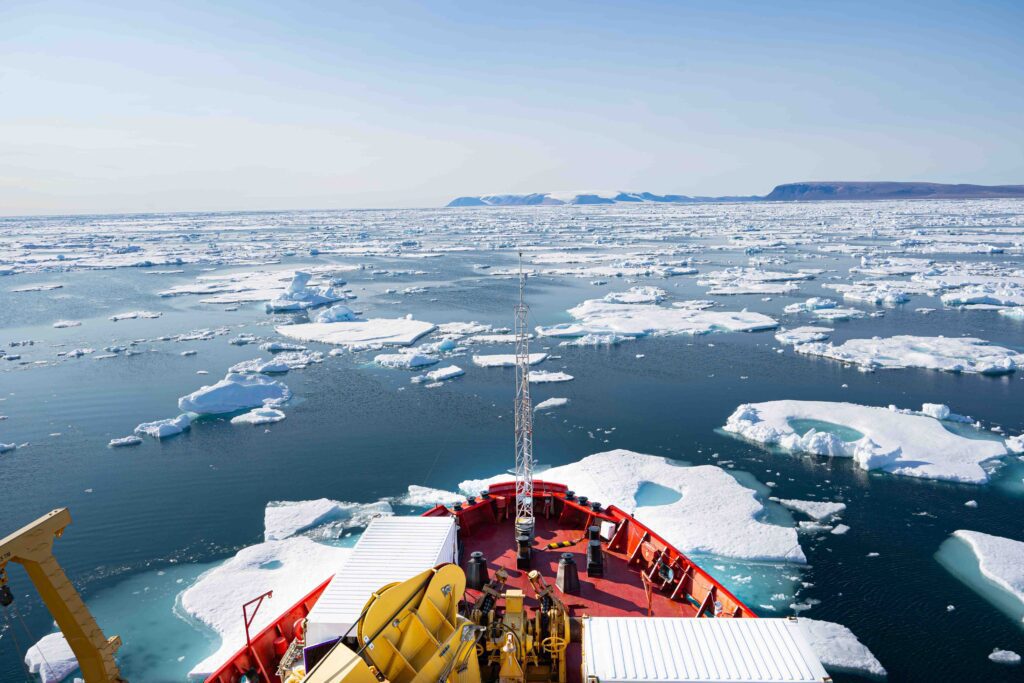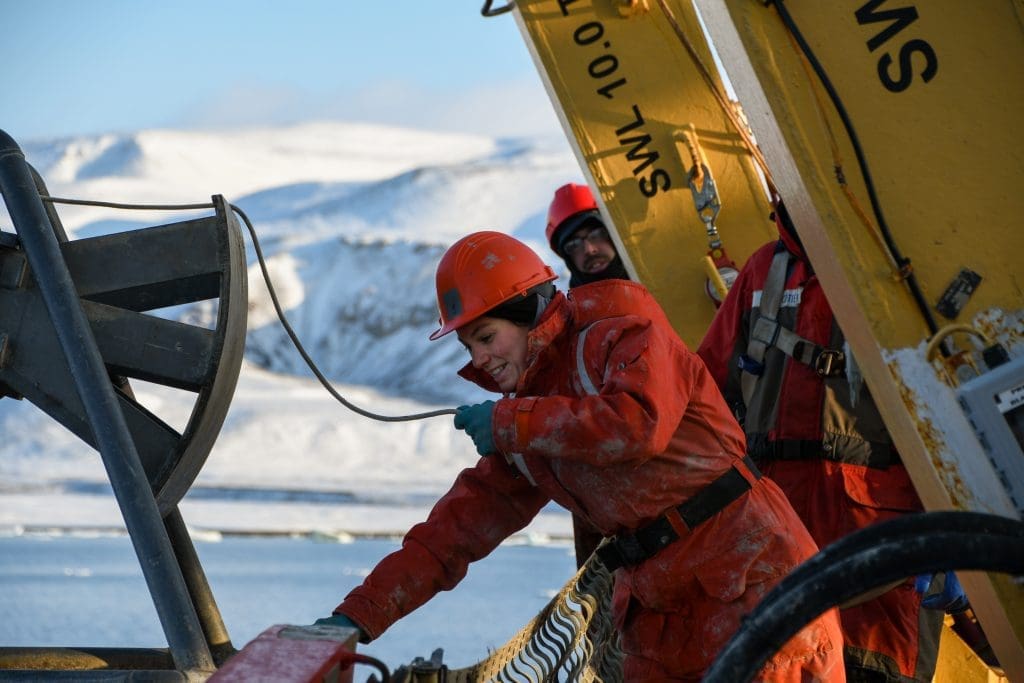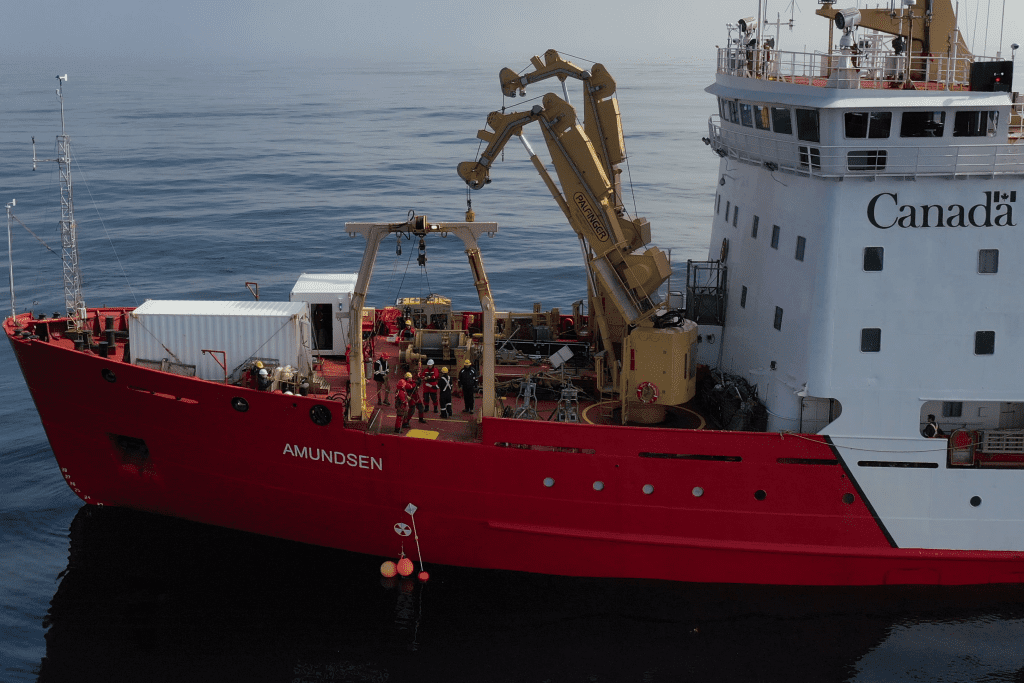Leg 1 – Mecatina Trough Survey
June 27 (Québec City) to July 10 (Goose Bay)
The first leg of the 2025 Amundsen Expedition marked the launch of a new program: the Mecatina Trough Survey, led by Fisheries and Oceans Canada, Memorial University, and UQAR.
This program aims to better understand the unique habitats and ecosystems of the Gulf of St. Lawrence and to collect baseline data from the Mecatina Trough.
Using the ship’s remotely operated vehicle (ROV), the scientific teams completed nine dives, exploring benthic communities and seafloor habitats. They observed a remarkable diversity of marine life: sponges, corals, anemones, crabs, fish, shrimp, and shellfish. Water, plankton, and fish samples were also collected to characterize biological productivity, biodiversity, and environmental conditions in the trough.
Leg 2 – Imappivut, DFO Benthic Refuges
July 10 (Goose Bay) to August 7 (Iqaluit)
The second leg began on July 10 in Goose Bay, Labrador, for 28 days of science at sea.
Primary programs leading operations included Imappivut and the DFO Benthic Refuges initiative, bringing together researchers from Fisheries and Oceans Canada, the Nunatsiavut Government, and various government and academic partners.
Now in its third year aboard the Amundsen, the Imappivut program focuses on identifying Vulnerable Marine Ecosystems (VMEs) in the coastal and offshore waters of Nunatsiavut, the Labrador Sea, and adjacent areas. The Benthic Refuges program aims to monitor sensitive seafloor habitats within Eastern Arctic Marine Refuges such as Hatton Basin, Davis Strait, and Disko Fan Conservation Areas.
Despite challenging weather and strong currents, nearly 200 scientific operations were successfully completed, including the first-ever Amundsen work in Lake Melville.The ship also sailed along the Nunatsiavut coast and Labrador Sea, conducting further ROV and camera surveys at sites such as the Makkovik Hanging Gardens and the Sentinel site.
A science day in Makkovik, organized by the Nunatsiavut Government in collaboration with Amundsen Science, brought together community members and scientists to exchange knowledge and stories about the local environment.
Leg 3 – KEBABB and TCA
August 7 (Iqaluit) to September 4 (Resolute Bay)
On August 7, the third leg began in Iqaluit, supporting returning programs KEBABB and Transforming Climate Action (TCA).
The KEBABB (Knowledge and Ecosystem-Based Approach in Baffin Bay) program investigates atmosphere–ice–ocean interactions and how climate change affects Arctic marine ecosystems. In collaboration with Fisheries and Oceans Canada, universities, and the Inuit Learning and Development Program, scientists conducted nine transects and carried out 227 scientific operations across Davis Strait.
Building on the 2024 operations, the TCA program teams mapped and sampled three fjords south of Qikiqtarjuaq, and completed the first-ever deployment of a benthic lander in the Arctic aboard the Amundsen. They also recovered one of the longest sediment cores ever collected on the ship — a 7.35-meter core from Coronation Fjord.
Professionals from the Qikiqtarjuaq Research Centre visited the Amundsen during this leg and joined the teams for operations in nearby waters.
Leg 4 – Queen Elizabeth Islands and Tuvaijuittuq Survey
September 4 (Resolute Bay) to October 2 (Resolute Bay)
The fourth leg brought the Amundsen to the far north for the Queen Elizabeth Islands (QEI) Survey, the main program of this phase. Building on previous work in the Tuvaijuittuq Marine Protected Area, scientists investigated freshwater pathways, ice–ocean interactions, and changing sea-ice conditions around the Queen Elizabeth Islands.
Despite navigating through old and thick ice, the Amundsen reached northern straits, fjords, and glaciers to conduct diverse sampling and mapping operations. In close collaboration with the Canadian Coast Guard, the teams sampled six sea-ice stations and three fjords within the Tuvaijuittuq MPA and in the southern areas of the Queen Elizabeth Islands.
After 28 days of Arctic fieldwork, the leg concluded on October 2 in Resolute Bay, where a community science day was held to share results and experiences with local residents.
Leg 5 – FoxSIPP
October 2 (Resolute Bay) to October 22 (Québec City)
The final leg of the expedition began on October 2 in Resolute Bay, with scientists embarking for 20 days of Arctic and subarctic research. A community science day was hosted in Iglulik on October 6, featuring meetings with local organizations, school activities, and a memorable performance by Artcirq, the world’s first Inuit circus troupe, a celebration of creativity, tradition, and science.
The leg’s main research effort, the FoxSIPP (Foxe Basin Sea Ice Pump) program, investigates the chemistry of deep waters formed annually in Foxe Basin and flowing into Foxe Channel. At the request of the local Hunters and Trappers Association (HTA), additional work was carried out in Steensby Inlet.
River sampling operations were also conducted using the ship’s helicopter in northern and western Foxe Basin.
The 2025 Amundsen Expedition concluded on October 22 with the ship’s return to Québec City and subsequent scientific demobilization.




























